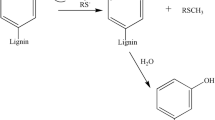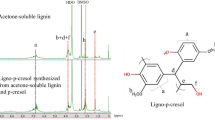Abstract
The search for bio-additives for enhancing the thermal and optical performance of epoxy resins has been increasing constantly. Lignin represents an interesting alternative for such purposes. Therefore, the aim of this work was promote the valorization of acetosolv coconut shell lignin (ACSL) and phosphorylated acetosolv coconut shell lignin (P-ACSL) as bio-additives in epoxy resins, evaluating their effects on the thermal and UV-blocking properties of the thermosetting materials. The phosphorylation of ACSL was carried out at 60 °C during 5, 10, and 20 min under microwave irradiation. ACSL and P-ACSL were characterized by TGA, DSC, GPC, and 1H and 31P NMR analyses. ACSL and P-ACSL were added to diglycidyl ether of bisphenol A (DGEBA) and isophoronediamine (IPDA) at 0, 0.5, 1.0, 2.5, 5.0, and 10 wt%, being cured at room temperature during 24 h. The neat and additivated epoxy resins were characterized by TGA, DSC, and UV-Vis analyses. It was observed a notorious enhancement of the thermal (≈ 9 °C for ACSL and P-ACSL) and thermo-oxidative (≈ 8.5 and 15 °C for ACSL and P-ACSL, respectively) stabilities of the thermosetting materials using both lignins, as well as for their glass transition temperatures (Tg), which presented a slight increase of 2.1 and 3.5 °C for ACSL and P-ACSL, respectively. Furthermore, ACSL and P-ACSL exhibited UV stabilizer properties through the complete absorption of UV light in the UV-A and UV-B regions. It can be concluded that P-ACSL could represent an alternative bio-additive that can be easily produced through a clean and fast methodology, capable of improving the thermal, optical, and chemical resistance properties of epoxy resins.











Similar content being viewed by others
References
Mestry S, Mhaske ST (2019) Synthesis of epoxy resins using phosphorus-based precursors for flame-retardant coating. J Coat Technol Res 16:807–818. https://doi.org/10.1007/s11998-018-00157-3
Asada C, Basnet S, Otsuka M, Sasaki C, Nakamura Y (2015) Epoxy resin synthesis using low molecular weight lignin separated from various lignocellulosic materials. Int J Biol Macromol 74:413–419. https://doi.org/10.1016/j.ijbiomac.2014.12.039
Rad ER, Vahabi H, Thomas S, De Anda AR, Saeb MR (2019) Bio-epoxy resins with inherent flame retardancy. Prog Org Coat 135:608–612. https://doi.org/10.1016/j.porgcoat.2019.05.046
Amrollahi S, Ramezanzadeh B, Yari H, Ramezanzadeh M, Mahdavian M (2019) In-situ growth of ceria nanoparticles on graphene oxide nanoplatelets to be used as a multifunctional (UV shield/radical scavenger/anticorrosive) hybrid compound for exterior coatings. Prog Org Coat 136:105241. https://doi.org/10.1016/j.porgcoat.2019.105241
Zhang J, Mi X, Chen S, Xu Z, Zhang D, Miao M, Wang J (2020) A bio-based hyperbranched fl ame retardant for epoxy resins. Chem Eng J 381:122719. https://doi.org/10.1016/j.cej.2019.122719
Huiyong LI, Degradation T (2007) Thermal and thermo-oxidative degradation of flame retardant high impact polystyrene with triphenyl phosphate and Novolac epoxy resin. J Wuhan Univ Technol Sci Ed 22:486–489. https://doi.org/10.1007/s11595-006-3486-3
Rakotomalala M, Wagner S, Dö M (2010) Recent developments in halogen free flame retardants for epoxy resins for electrical and electronic applications. Materials (Basel) 3:4300–4327. https://doi.org/10.3390/ma3084300
Costes L, Laoutid F, Brohez S, Dubois P (2017) Bio-based flame retardants: when nature meets fire protection. Mater Sci Eng R Rep 117:1–25. https://doi.org/10.1016/j.mser.2017.04.001
Illy N, Fache M, Ménard R, Negrell C, Caillol S, David G (2015) Phosphorylation of bio-based compounds: the state of the art. Polym Chem 6:6257–6291. https://doi.org/10.1039/c5py00812c
Prieur B, Meub M, Wittemann M, Klein R, Bellayer S, Fontaine G, Bourbigot S (2017) Phosphorylation of lignin: characterization and investigation of the thermal decomposition. RSC Adv 7:16866–16877. https://doi.org/10.1039/c7ra00295e
Avelino F, De Oliveira DR, Mazzetto SE, Lomonaco D (2019) Poly(methyl methacrylate) films reinforced with coconut shell lignin fractions to enhance their UV-blocking, antioxidant and thermo-mechanical properties. Int J Biol Macromol 125:171–180. https://doi.org/10.1016/j.ijbiomac.2018.12.043
Prieur B, Meub M, Wittemann M, Klein R, Bellayer S, Fontaine G, Bourbigot S (2016) Phosphorylation of lignin to flame retard acrylonitrile butadiene styrene (ABS). Polym Degrad Stab 127:32–43. https://doi.org/10.1016/j.polymdegradstab.2016.01.015
Su G, Crump D, Letcher RJ, Kennedy SW (2014) Rapid in vitro metabolism of the flame retardant triphenyl phosphate and effects on cytotoxicity and mRNA expression in chicken embryonic hepatocytes. Environ Sci Technol 48:13511–13519
Bykov GL, Ershov BG (2010) A sorbent based on phosphorylated lignin. Russ J Appl Chem 83:316–319. https://doi.org/10.1134/S1070427210020254
Kostas ET, Beneroso D, Robinson JP (2017) The application of microwave heating in bioenergy : a review on the microwave pre-treatment and upgrading technologies for biomass. Renew Sust Energ Rev 77:12–27. https://doi.org/10.1016/j.rser.2017.03.135
Díaz-Ortiz A, Prieto P, de la Hoz A (2019) A critical overview on the effect of microwave irradiation in organic synthesis. Chem Rec 19:85–97. https://doi.org/10.1002/tcr.201800059
Kappe CO (2004) Controlled microwave heating in modern organic synthesis. Angew Chem 43:6250–6284. https://doi.org/10.1007/s11030-009-9138-8
Avelino F, Marques F, Soares AKL, Silva TK, Leitao RC, Mazzetto SE, Lomonaco D (2019) Microwave-assisted organosolv delignification : a potential eco-designed process for scalable valorization of agroindustrial wastes. Ind Eng Chem Res 58:10698–10706. https://doi.org/10.1021/acs.iecr.9b01168
Avelino F, da Silva KT, Filho M d SMS, Mazzetto SE, Lomonaco D (2018) Microwave-assisted organosolv extraction of coconut shell lignin by Brønsted and Lewis acids catalysts. J Clean Prod 189:785–796. https://doi.org/10.1016/J.JCLEPRO.2018.04.126
ASTM E2009–08 (2009) Standard test methods for oxidation onset temperature of hydrocarbons by differential scanning calorimetry. ASTM Int. https://doi.org/10.1520/E2009-08R14E01.2
Sadeghifar H, Venditti R, Jur J, Gorga RE, Pawlak JJ (2017) Cellulose-lignin biodegradable and flexible UV protection film. ACS Sustain Chem Eng 5:625–631. https://doi.org/10.1021/acssuschemeng.6b02003
ASTM Standard D 2765–11: Standard test methods for determination of gel content and swell ratio of crosslinked ethylene plastics (2011) ASTM Standard D 2765–11, Standard Test Methods for Determination of Gel Content and Swell Ratio of Crosslinked Ethylene Plastics https://doi.org/10.1520/D2765-11
Oliveira JR, Kotzebue LRV, Ribeiro FWM, Mota BC, Mazzetto SE, Ishida H, Lomonaco D (2017) Microwave-assisted solvent-free synthesis of novel benzoxazines : a faster and environmentally friendly route to the development of bio-based thermosetting resins. J Polym Sci Part A Polym Chem 55:3534–3544. https://doi.org/10.1002/pola.28755
de Oliveira DR, Nogueira I d M, Maia FJN, Rosa MF, Mazzetto SE, Lomonaco D (2017) Ecofriendly modification of acetosolv lignin from oil palm biomass for improvement of PMMA thermo-oxidative properties. J Appl Polym Sci 134:1–8. https://doi.org/10.1002/app.45498
Gioia C, Re GL, Lawoko M, Berglund L (2018) Tunable thermosetting epoxies based on fractionated and well-characterized lignins. J Am Chem Soc Chem Soc 140:4054–4061. https://doi.org/10.1021/jacs.7b13620
Wilkie CA, Morgan AB (2010) Fire retardancy of polymeric materials, 2nd edn. CRC Press, Boca Raton
Alalykin AA, Vesnin RL, Kozulin DA (2011) Preparation of modified hydrolysis lignin and its use for filling epoxy polymers and enhancing their flame resistance. Russ J Appl Chem 84:1616–1622. https://doi.org/10.1134/s1070427211090278
Nikafshar S, Zabihi O, Ahmadi M, Mirmohseni A, Taseidifar M, Naebe M (2017) The effects of UV light on the chemical and mechanical properties of a transparent epoxy-diamine system in the presence of an organic UV absorber. Materials (Basel) 10:1–18. https://doi.org/10.3390/ma10020180
Acknowledgments
The authors acknowledge CENAUREMN (Centro Nordestino de Ressonância Magnética Nuclear at Fortaleza, Brazil) for NMR analyses and DuCoco Produtos Saudáveis for gently donate the coconut shells.
Funding
The study was funded by Brazilian agencies CNPq, CAPES, and FUNCAP.
Author information
Authors and Affiliations
Corresponding author
Additional information
Publisher’s Note
Springer Nature remains neutral with regard to jurisdictional claims in published maps and institutional affiliations.
Electronic supplementary material
ESM 1
(DOCX 1233 kb)
Rights and permissions
About this article
Cite this article
Marciano, S.J., Avelino, F., da Silva, L.R.R. et al. Microwave-assisted phosphorylation of organosolv lignin: new bio-additives for improvement of epoxy resins performance. Biomass Conv. Bioref. 12, 619–631 (2022). https://doi.org/10.1007/s13399-020-01048-7
Received:
Revised:
Accepted:
Published:
Issue Date:
DOI: https://doi.org/10.1007/s13399-020-01048-7




